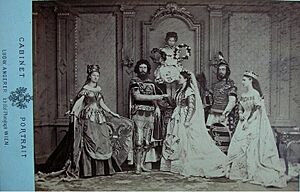Tableau vivant facts for kids


A tableau vivant (say "tab-loh vee-vahn") means 'living picture' in French. It's a scene where one or more people pose perfectly still and silent. They usually wear costumes and use props or scenery. Special lights might make the scene look even better.
It's like a mix of acting and visual art. These "living pictures" were popular a long time ago, in the Middle Ages. They became very popular again in the 1800s. This was partly because cameras could easily take pictures of them.
Most people taking part were not professional actors. It was a fun and easy way for people to do some amateur acting. You could put a tableau together quickly, and it didn't need much acting or speaking skill. They were also popular for community events and parades.
Today, you can still see tableaux vivants. Some street performers act as living statues, posing in costumes for people passing by. In movies or plays, actors sometimes freeze for a moment to create a "living picture" effect.
The History of Living Pictures
In the Middle Ages, sometimes a church service or a play would include short, dramatic scenes. These scenes were like paintings that came to life. They were a big part of celebrations for royal weddings, coronations, and when kings or queens visited cities.
Often, the actors would pretend to be statues or figures from paintings. They did this in large groups on fancy temporary stages. These stages were set up along the path of a main parade. Many old paintings and sculptures might even show what these living pictures looked like. Artists often helped design these public shows.
Before modern art, Western art often focused on arranged, symbolic scenes. Artists would use models who posed in costumes. You could think of these as small "living pictures" with the artist as the audience. The idea of showing things exactly as they are (called Realism) didn't become popular until the mid-1800s.
The invention of photography made living pictures popular again. At first, photography was expensive. So, these scenes were often put on at parties in the big country houses of rich English families. Queen Victoria loved them, but she preferred to watch.
In the mid-1850s, her own children performed tableaux for their parents' 14th wedding anniversary. By the 1890s, the scenes became very detailed. For example, Queen Victoria's son, Prince Arthur, Duke of Connaught and Strathearn, and his family posed for a "Japanese Scene" in 1891. Living pictures also became popular for community events and festivals. Children often took part, parading before posing for the audience and a camera.
Living Pictures on Stage
Before radio, movies, and television, living pictures were a popular form of entertainment. This was true even in small towns in America. Before we had color pictures, tableaux were sometimes used to show famous artworks on stage. They would recreate a painting based on a drawing or sketch.
People could do this as a fun hobby at home, or as a more professional show in a theater. One scene would follow another, usually telling a story. This was a way to put on a show without needing all the usual costumes and sets of a full play. These shows influenced later Victorian and Edwardian era magic lantern shows. They might also have influenced early comic strips.
Living pictures were often part of school Nativity plays in England during the Victorian period. This tradition is still done at Loughborough High School, one of England's oldest girls' grammar schools. Several tableaux are performed each year at the school's carol service. One scene even shows an engraving where the subjects are painted and dressed completely grey.
Tableaux were also performed to raise money for charity. In 1917, an American magazine called Harper's Bazar showed many photos of two events in London. At these events, high-society ladies posed as famous paintings. One event focused on paintings by James McNeill Whistler and John Singer Sargent. The other included famous people like Violet Trefusis and Lady Diana Cooper.
Living pictures were sometimes part of fairground sideshows. These shows mostly disappeared by the 1970s. However, they still happen at the Bridgewater Carnival in Somerset, England. Tableaux are also a big attraction at the yearly Pageant of the Masters in Laguna Beach, California.
Living Pictures in Movies
Living pictures have appeared in many films:
- In Pier Paolo Pasolini's 1963 film La ricotta, a filmmaker tries to have actors recreate two paintings of Jesus's Passion.
- The 1969 film The Color of Pomegranates shows the life of Armenian poet Sayat Nova. It uses a series of living pictures of Armenian costumes and religious rituals.
- Jean-Luc Godard's film Passion (1982) is about making an art film. This film uses recreations of famous European paintings as living pictures. These scenes are set to classical music.
- In Derek Jarman's film Caravaggio (1986 film), many of Caravaggio's paintings are recreated as living pictures. This helps explore how the paintings relate to the artist's life.
- The 1991 film My Own Private Idaho uses this effect for its romantic scenes.
- The 2013 film, A Field in England, uses the effect to make the film look more mysterious.
- There is a 2014 Estonian film called In the Crosswind that is made entirely in the living picture style.
See Also
 In Spanish: Tableau vivant para niños
In Spanish: Tableau vivant para niños
- Historical reenactment
- Living history
- Living statue
- Mannequin Challenge
- Oberammergau Passion Play. This play is performed every ten years in Oberammergau, Germany. It includes several living pictures showing scenes from the Old Testament.

